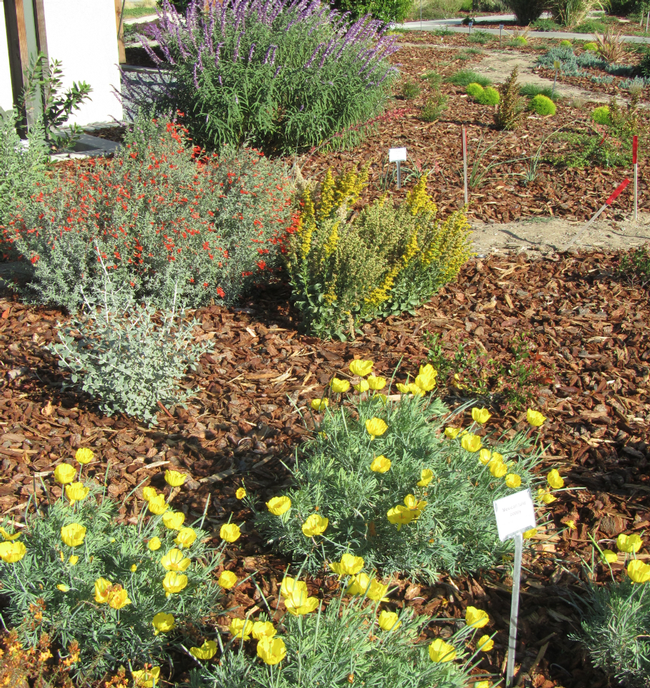[From March 2014 issue of the Retail Nursery and Garden Center IPM News.]
Anything used to cover the surface of the soil in a landscape or garden is called mulch. Most retail nurseries and garden centers sell a variety of mulch products in smaller bagged quantities or rolls. Mulch may be inorganic, like rock or chipped rubber; organic, such as straw, shredded leaves, chipped wood or bark; or synthetic landscape fabric. Mulch is often confused with compost; but while compost may be used as mulch, its primary use is as a soil amendment. 
Why use mulch?
Extensive research has been done over the years to determine the effects of using different types of mulch. The following benefits of organic mulch have been repeatedly confirmed:
- Less water is lost from the soil. With the surface covered, less evaporation occurs, reducing your water need.
- Soil temperatures fluctuate less. Soil stays cooler in summer and warmer in winter. This is a healthier environment for root growth and function, and fewer plants die from heat stress or frost damage. This is especially important for shallow-rooted plants.
- Weeds are reduced. Excluding light reduces the number of weed seeds that sprout and those that do are easier to remove.
- Water infiltration increases. Covering the soil surface prevents crusting that may cause water to run off.
- Soil and plant health is improved. Soil structure, nutrient levels, beneficial microbial activity, and other factors of soil health are all increased over time with the use of organic mulch.
Organic vs. Inorganic mulches
Although inorganic mulch may have some of the same benefits as organic mulch, it does not improve soil health over time.
- Rocks are appropriate for specific landscape situations, such as dry river beds, sections for succulents and other rock garden plants, or gravel for paths that allow water to infiltrate. Rocks absorb and hold a great deal of heat, and care should be taken to locate only heat-tolerant plants in or adjacent to rocks.
- Rubber mulch should be reserved for under jungle gyms where its greatest feature, shock-absorbency, can be of use. It adds nothing beneficial to the soil, and may release toxic heavy metals into the soil or runoff water, especially if the source is recycled truck tires.
- Geotextiles or landscape fabrics are synthetic mulches that are porous and allow water and air to pass through. These materials are great for long-term weed control, especially around trees and shrubs and should be covered with an organic mulch. Products with UV light inhibitors will last longer.
- Black plastic is not recommended because it is not permeable to air or water and tears easily.
Organic Mulches: What type and how deep?
Organic mulches come in all types of sizes and from many sources. Each has appropriate uses and application recommendations. Larger chunks (1.5 inch) stay put in windy areas and are perfect for large-scale landscapes and for under trees. The weight and size, however, can cause them to roll off steep slopes. With large shrubs and trees, a 3 to 4-inch layer should last about 3 years before needing to be topped off. Be sure to keep the mulch at least 3 to 12 inches from the base of the trunks to prevent rot.
The shredded “gorilla-hair” type product weaves together and holds best on slopes. Smaller bark nuggets or chipped wood work nicely in beds with smaller or delicate plants like annuals or tender perennials. A 2 to 3-inch layer will provide benefits without smothering plants. Be aware that it will break down and need to be replaced about every other year. In very windy areas, it may also be prone to blowing away.
Finely ground products such as composts with less than ¼ inch particle size are less suitable as mulches. These particles can pack tightly, hold water away from roots, and remain undesirably soggy. Mulch breaks down rapidly into a substrate for weed growth. Peat moss is an especially poor mulch as it does not allow water to penetrate.
Other things to consider:
- Never use mulch right next to the street curb. In heavy rains the mulch could float away, clogging storm drains and adding an excess of solid material if carried into the stormwater system.
- If gardening in a region with high summer temperatures, use black-dyed mulch only in shade. If used in sun, the mulch absorbs heat and actually raises soil and surface temperatures high enough to scorch plant leaves it contacts. In cooler, coastal climates, this effect can be used to your advantage by warming the soil in the early season to help your tomatoes get a head start.
- Mulch large landscape pots and planters. Though often overlooked, large landscape pots for small trees, shrubs, topiary, or seasonal color, benefit greatly from the the addition of a 1 to 2-inch layer of organic mulch. Water use is significantly reduced by covering the pot soil.
This article was originally published in the March 2014 issue of the Retail Nursery and Garden Center IPM News. See this and other articles at http://www.ipm.ucdavis.edu/RETAIL/retail-newsletter.html.